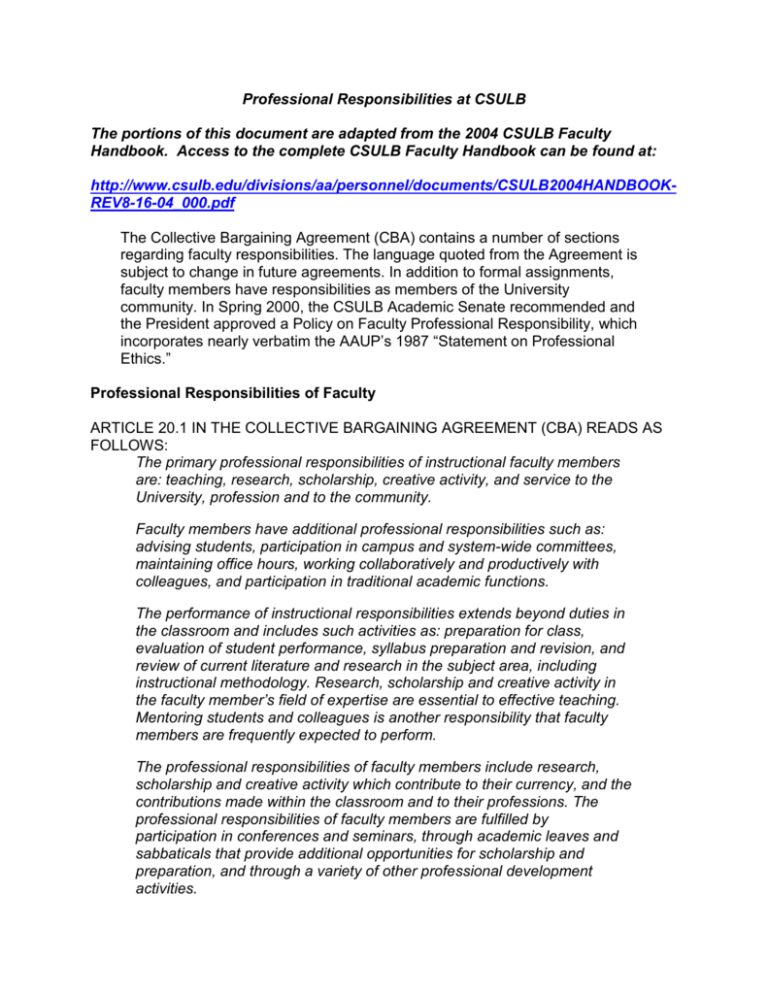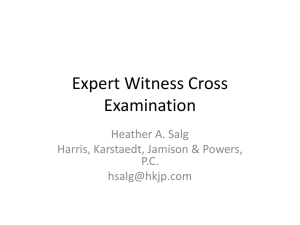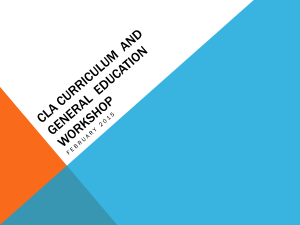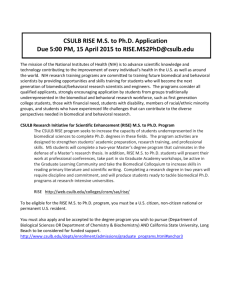Professional Responsibilities at CSULB
advertisement

Professional Responsibilities at CSULB The portions of this document are adapted from the 2004 CSULB Faculty Handbook. Access to the complete CSULB Faculty Handbook can be found at: http://www.csulb.edu/divisions/aa/personnel/documents/CSULB2004HANDBOOKREV8-16-04_000.pdf The Collective Bargaining Agreement (CBA) contains a number of sections regarding faculty responsibilities. The language quoted from the Agreement is subject to change in future agreements. In addition to formal assignments, faculty members have responsibilities as members of the University community. In Spring 2000, the CSULB Academic Senate recommended and the President approved a Policy on Faculty Professional Responsibility, which incorporates nearly verbatim the AAUP’s 1987 “Statement on Professional Ethics.” Professional Responsibilities of Faculty ARTICLE 20.1 IN THE COLLECTIVE BARGAINING AGREEMENT (CBA) READS AS FOLLOWS: The primary professional responsibilities of instructional faculty members are: teaching, research, scholarship, creative activity, and service to the University, profession and to the community. Faculty members have additional professional responsibilities such as: advising students, participation in campus and system-wide committees, maintaining office hours, working collaboratively and productively with colleagues, and participation in traditional academic functions. The performance of instructional responsibilities extends beyond duties in the classroom and includes such activities as: preparation for class, evaluation of student performance, syllabus preparation and revision, and review of current literature and research in the subject area, including instructional methodology. Research, scholarship and creative activity in the faculty member’s field of expertise are essential to effective teaching. Mentoring students and colleagues is another responsibility that faculty members are frequently expected to perform. The professional responsibilities of faculty members include research, scholarship and creative activity which contribute to their currency, and the contributions made within the classroom and to their professions. The professional responsibilities of faculty members are fulfilled by participation in conferences and seminars, through academic leaves and sabbaticals that provide additional opportunities for scholarship and preparation, and through a variety of other professional development activities. The parties understand that instructional faculty members may not normally participate in all activities identified in this Article during each academic term or year. Academic Freedom and Professional Responsibilities Defining Academic Freedom Academic freedom is central to the heart of the academy. Unfortunately the term is often misunderstood and misapplied. The very first standard for accreditation by our regional accrediting agency, the Western Association of Schools and Colleges, includes the statements: An institution of higher education is, by definition, dedicated to the search for truth and its dissemination. As a consequence, faculty, students, administrators, trustees, and staff are committed to and supported in the free pursuit of knowledge and the expression of ideas. .... the protection of the freedom for faculty and students to examine all pertinent data, to question assumptions, to be guided by the evidence of scholarly research, and to teach and study the substance of a given field is crucial to the integrity of an educational institution. Faculty Responsibilities and Academic Freedom Faculty Responsibilities As teachers and scholars, we have the responsibility to examine all sides of a question and to be guided by the evidence of scholarly research. As faculty members, we have the responsibility to guard the rights of our colleagues to pursue truth. As teachers, we have the responsibility to teach our students what academic freedom means. As citizens, we must remember that the purpose of academic freedom is to protect society against those who might seek to suppress unpopular facts. Responsibilities to Our Students We have considerable latitude in choosing assignments to help students achieve the course objectives but there are limits to that latitude. We have the right to require that students complete those assignments, so long as we are not putting them in danger or setting requirements that cannot be completed by disabled students. We do not have the right to teach a class that does not meet the catalog description or the department’s objectives for that class. We do not have a right to use considerable class time for things that have nothing to do with the course. We certainly do not have the right to insist that students agree with all our ideas. We must allow them, too, the freedom to examine all sides of a question, to question assumptions, and to come to conclusions based on the evidence, even if those conclusions are different from our own. University Responsibilities and Academic Freedom The University, in turn, is committed to protecting its faculty from undue coercion or threat in order that the faculty can Promote and preserve the conditions of free inquiry necessary to fulfill the obligations of their academic disciplines; Discharge their academic responsibilities to their students, to their colleagues, to their professions and disciplines, and to their institution; Speak or act as private citizens. Scheduling of Work Assignment Class Scheduling The instructional assignments of individual faculty members in the classroom, laboratory, or studio will be determined by the appropriate administrator after consultation with the department chair or designee and/or the individual faculty member. The department or other appropriate unit’s overall instructional or course assignments shall be consistent with department and student needs. Departments vary in the way in which they build schedules and determine individual teaching assignments, but most give faculty members some opportunity to express a preference for particular courses or times. These preferences cannot always be accommodated. All departments are constrained by availability of rooms. Sometimes courses must be scheduled at particular times to meet the needs of evening students or to make it possible for students to take several required courses in the same semester. Members of the bargaining unit shall not be required to teach an excessive number of contact hours, assume an excessive student load, or be assigned an unreasonable workload or schedule. Members of the bargaining unit shall not be required to teach an excessive number of contact hours, assume an excessive student load, or be assigned an unreasonable workload or schedule. ( Weighted Teaching Units (WTU) In general, one WTU is equated to each hour of class time in lecture classes. Laboratory and activity classes, and independent study supervision, are counted differently, according to various formulas. Before 1995, full-time faculty workload was defined as 12 WTU a semester. Although this definition of workload was abandoned as of the Collective Bargaining Agreement signed in 1995, salaries for part-time faculty and summer session faculty are based on the number of WTU, and faculty workload continues to be reported in the old way for comparison purposes. This reporting includes accounting for certain duties not based on classroom schedules (i.e., “assigned time.”) Office Hours The purpose of office hours is to provide opportunities for student-faculty interaction outside the classroom; it is important for the office hours of a faculty member to be predictable. Each instructional faculty member is expected to hold one office hour for every class taught, up to a maximum of four hours required. If you are expected to hold four office hours a week, you may account for up to one hour of the expectation through alternative forms of access such as availability by appointment or through e-mail. You must notify your department office of your office hours during the first week of the semester and must list your office hours, phone number, and e-mail contact in each course syllabus and on a notice posted outside your office door. The office hours should be spread over the week and at times students might reasonably expect to find you. For example, if you teach an evening class, you should schedule an office hour in the evening. If you have assigned time for advising or similar work with students, you are expected to schedule additional office hours so you will be available to assist students. Absences Sick Leave For each month of qualifying service, full-time faculty accumulate eight hours of credit for sick leave with pay. If you must miss work because you are ill or because you must look after an immediate relative who is ill, notify your department chair immediately. When you return to work, fill out an Absence and Additional Time Worked Report Form. Absence from Work for Reasons other than Illness If you must miss a class for a reason other than illness, obtain prior permission from your Department Chair. Absence from class for any reason should be reported on a Notice of Absence from Class/Class Cancellation, a form that is available in your department office or on the Academic Personnel web site under forms. If someone is to substitute for you in teaching a class, that person must be qualified to teach the class. A graduate assistant or student assistant is not an acceptable substitute. You cannot be paid for days when you are absent unless (1) the absence is authorized and (2) the absence is approved for conferences, workshops, and other professional meetings. Bereavement Leave When requested, academic employees are granted two days leave of absence with pay for each death in the immediate family; three days if you must travel over 500 miles from your home. Personal Holiday All academic employees are entitled to a one day Personal Holiday each calendar year. If the Personal Holiday is not taken before the end of the year, it is forfeited. Scheduling of the Personal Holiday must be by mutual agreement of the faculty member and the Department Chair or the appropriate administrator. Maternity/Paternity/Adoption Leave Maternity/Paternity/Adoption Leave is a paid leave of up to 30 days for the birth of an employee's own child or the placement of a child with the employee in connection with adoption or foster care. The thirty days paid leave must be taken within 60 days of the arrival of the child. An additional 10 days of earned sick leave may be used in conjunction with maternity leave for recovery from childbirth. A physician’s statement is required for usage of sick leave exceeding ten days. Maternity/Paternity/Adoption Leave runs concurrently with any other related leave to which a faculty member is entitled. Short-term disability (NDI) may also be available for maternity leave. Maternity Leave does not constitute a break in service. Contact Employee Relations for more information, 5-1742. Jury Duty Faculty members are not unconditionally exempt from serving on jury duty. The CSU will continue your salary while on jury duty. The performance of jury duty is a paid absence when the employee remits the fee to the state. For those employees with accrued vacation credit, jury duty may be taken on vacation time and the fee received for jury duty may be retained. The summons to Jury Duty must be submitted to the Administrative Support Coordinator in your department. Absence as a Witness A faculty member serving as a court-subpoenaed witness or as an expert witness in the interest of the CSU may seek payment of witness fees. A faculty member who is absent as a court-subpoenaed witness or as an expert witness in the interest of the CSU shall be paid the normal salary for the corresponding period of absence. No portion of the employee's salary may be forfeited as the result of such an appearance; however, all court fees (except personal travel and/or subsistence payments) shall be remitted to the CSU. If an exceptional circumstance occurs whereby the faculty member does not remit such fees, an amount equal to the fees shall be deducted from the faculty member’s salary. No vacation or compensatory time off (CTO) shall be used in such cases. Catastrophic Leave Donation Program The Catastrophic Leave Donation Program allows any CSU employee who accrues vacation or sick leave credits to voluntarily donate either of those credits to any other eligible CSU employee on the same campus in the event of a catastrophic illness or injury. Employees may donate up to a maximum of sixteen hours per fiscal year in increments of one hour or more. Donations that are used are irrevocable. A catastrophic illness or injury is one that makes it impossible for the employee to work. Catastrophic illness or injury may also include an incapacitated member of the employee’s immediate family. Only donated vacation credits can be used for family care catastrophic leave. Contact Employee Relations for more information, 5-1742. Course Policies Grading Policies As part of your teaching responsibilities, you are required to evaluate the academic performance of students. Policies on grading are printed in the catalog. University policy requires that final grades shall b based on at least three, and preferably four or more, demonstrations of competence by the student. In no case shall the grade on the final examination count for more than one-third of the course grade. At the start of the course, instructors shall provide to their students in writing the grading policies and practices to be employed in the class and the rules that will apply to withdrawals. Instructors are expected to provide students with an opportunity for demonstration of competence, relevant to the determination of their final grade in the course, as early as is reasonable and no later than the mid-point of the term. Students have a right to be informed promptly of their scores and to review each of their demonstrations of competence with their instructors. If materials submitted for a demonstration of competence are not returned, these materials will be retained for one semester by the instructor. Should the instructor be absent during that term, the materials shall be retained in the department office. In the absence of the original instructor, a qualified instructor may be appointed by the chair to review the demonstration of competence with the student. You are also encouraged to include additional information about matters relevant to the particular class and to your personal expectations. A clear description helps students know what you expect and can help avert arguments and grade appeals. Faculty members in your department may have materials they have found useful. Here are some examples of such materials. o A grading rubric for papers. o When class discussion is a substantial part of the course, provide information on how grades will be determined. If the course includes group assignments, it is useful to explain the objective of the assignment (e.g. whether the extent of cooperation with others is considered) and the basis for the grade given to each member of the group. o Explain how cheating or plagiarism will be interpreted in the course. o Present a clearly stated and written policy on late assignments. o Faculty members differ greatly in their expectations on conduct in the classroom. The syllabus is a good place to explain your rules on matters such as use of cell phones, late arrival, eating in class, or other issues. Grades and Grading Procedures The following definitions apply to grades assigned in all undergraduate and graduate courses. “A” – Performance of the student has been at the highest level, showing sustained excellence in meeting all course requirements and exhibiting an unusual degree of intellectual initiative. “B” – Performance of the student has been at a high level, showing consistent and effective achievement in meeting course requirements. “C” – Performance of the student has been at an adequate level, meeting the basic requirements of the course. “D” – Performance of the student has been less than adequate, meeting only the minimum course requirements. Class Meetings Times and Locations All classes must be held in the spaces and during the times listed in the official Schedule of Classes. If the assigned room is unsatisfactory, ask your Department Chair or scheduler whether it is possible to find an alternate room. You may not teach a class in an off-campus location, except for scheduled field trips, unless it has been approved by the University. If you do hold a field trip or other class off campus, make sure it will not interfere with the students’ other classes and will not create a hardship for students who cannot provide their own transportation or insurance. Course Content Departments have responsibility for assuring that the course content matches that described in the Catalog and in the department’s Standard Course Outline. Departments have responsibility for assuring continuity in sequential courses, and for assuring that multiple sections of a course are similar in content and level of instruction. If you wish to teach a course in a way that is very different from the way it is taught in other sections, consult your Department Chair. Innovation in teaching strategy is welcomed, but there can be problems when one instructor presents a course that departs greatly from the content or level described in the catalog.










